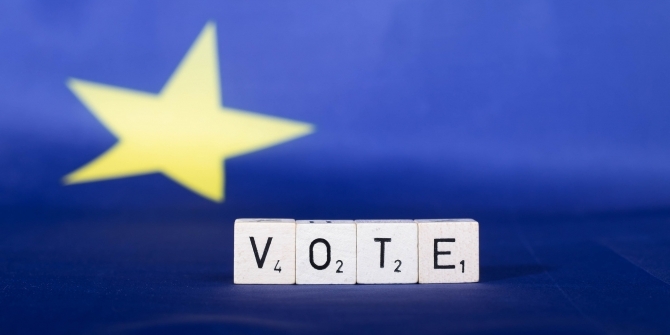 What if the solution for the Brexit shambles does lie with the EU? In this blog, Stijn Smismans (Cardiff University) proposes the tool of a Protocol to the Withdrawal Agreement, instead of a Political Declaration, as a way to change the dynamics of cross-party compromise on a new deal.
What if the solution for the Brexit shambles does lie with the EU? In this blog, Stijn Smismans (Cardiff University) proposes the tool of a Protocol to the Withdrawal Agreement, instead of a Political Declaration, as a way to change the dynamics of cross-party compromise on a new deal.
Arguably the UK government has only itself to blame for the political and constitutional Brexit drama. The referendum was characterised by an extremely poorly informed political debate, packed with lies, half-truths and even illegal funding. The tight win for Leave was immediately turned by Theresa May into a mandate for Brexit inspired by hard Brexiters. Her red lines became a dogma, used by the government to turn inwards on itself, ignoring all other opinions, and unavoidably leading to a Withdrawal Agreement that was massively defeated in Parliament. The leader of the opposition sat in the corner of the room, covered his eyes and ears, and (in good old style Marxist tradition) would rather wait until Brexit and the Tory government bring the country to its knees, from which the revolution would rise and Britain would become the socialist paradise on earth, proudly fighting its own corner in a globalised world.
It is perfectly understandable that the EU expects the UK to sort out its own mess first so that the UK government comes up with a Brexit proposal that has a mandate from a majority in Parliament. However, the first days after the ‘meaningful vote’ have shown hardly any sign of either the Prime Minister or the leader of the opposition changing position to overcome the deadlock through a cross-party solution that will finally put the interest of the country first. The current deal is dead. Neither May or Corbyn want a referendum. May sticks to her red lines and Corbyn refuses to engage, making any chances of a majority supporting an amended deal almost impossible. The risk of a no deal, which is the default scenario according to Article 50, is therefore seriously increasing, although nobody (except for a fringe on the hard Brexit side) wants this outcome.

For the EU, a no deal scenario would not constitute a disaster like for the UK, but it is nevertheless pretty disruptive and has an economic cost. So, is there any way in which the EU can c rescue the UK, as the latter fails to save itself?
The EU will not give up the defence of its Member States or undermine the integrity of the Union. So, it is highly unlikely that it will revise the Withdrawal Agreement or offer other options for the future relationship than those proposed from the start of the Brexit negotiations. However, the EU could provide more detail on the direction of the future relationship. Moreover, my key argument here is that the EU could offer to set out the key features of the framework for that relationship in a legally strengthened way. This, in turn, could change the dynamics in the search for compromise in the UK Parliament.
I argue that this can be done via a Protocol attached to the Withdrawal Agreement. Protocols, like Political Declarations, are used by the EU as attachments to EU treaties. They provide clarifications or commitments that do not fit well within the core text of the Treaty, for instance, because, although they are agreed by all Member States, they only apply to, or are more relevant for, some of them, and thus less suited to put in the ‘constitutional’ design provided by the core text of the Treaties. An example is the Protocol that keeps the UK out of the Euro. However, unlike Political Declarations, Protocols are legally binding in the same way as the core text of the EU Treaties.
The idea to use Protocols in the context of the Withdrawal Agreement is not new. I have proposed myself some time ago to use a Protocol to strengthen the protection of the 3 million EU citizens in the UK, which would make binding the UK’s promises on how it would implement its registration system for these citizens. More recently, Holger Hestermeyer proposed the use of a Protocol to provide more legally binding detail on the backstop, in the hope that this would convince some MPs to accept the current deal, while not having to amend the Withdrawal Agreement itself, which the EU is not keen to do. The problem with this approach is that commitments on the backstop are likely to convince, at best, the DUP and a couple of Conservative MPs. For hard Brexiters, the backstop is just an excuse to reject the Withdrawal Agreement and concessions on it will never be enough. Most importantly, for those who voted against the deal from a Remain or soft-Brexit perspective, the backstop is not really the issue.
The only way to find a majority in Parliament for any sort of Brexit deal is to move it towards a softer Brexit. Hard Brexiters have agitated so loudly against the deal that it is difficult to imagine whether there are any amendments (also acceptable to the EU) that could convince enough of them to approve the deal. Movement towards a softer Brexit can be done by amending the Political Declaration, leaving the Withdrawal Agreement pretty much untouched.
However, why would a Remainer, or even a convinced soft-Brexiter, be it on the Tory, Labour, Lib Dem, SNP, Plaid or Green benches, accept a compromise on a soft Brexit that is only set out in a non-binding Political Declaration? It would simply take the UK irreversibly out of the EU on 29 March, after which negotiations on the future trade relationship could still end up in a hard Brexit Canada style rather than a soft Brexit Norway style. Tinkering with the Political Declaration is therefore unlikely to obtain sufficient support from Remainers.
A Protocol can provide a solution to this problem, as it allows setting out in a binding way the broad framework for a soft Brexit future relationship. Such stronger guarantees avoiding a hard Brexit may move sufficient MPs to compromise on a cross-party deal.
Yet, since the EU has chosen to define the framework for the future relationship in a Political Declaration, can a Protocol be used instead? According to Article 50 of the Treaty on European Union, the Union shall negotiate and conclude an agreement with the withdrawing State, “setting out the arrangements for its withdrawal, taking account of the framework for its future relationship with the Union.” It clearly implies that there are two parts to negotiating a withdrawal from the EU, namely one part dealing with immediate aspects of withdrawal and the disentanglement of the exiting state from the EU’s legal order and another part dealing with defining a future relationship. There are two reasons for this dual negotiation process. Defining a future trade relationship will take years, potentially a decade, and waiting that long without any sign of ‘getting out’ would be difficult to swallow for a country once it has decided to leave. A first withdrawal agreement on divorce issues thus makes sense.
Moreover, while the Member States have given the EU a wide horizontal competence in Article 50 to deal with the withdrawal of a Member State, by way of qualified majority voting in the Council and consent of the European Parliament, it is unlikely that they had the intention to give the EU similar power to set out in detail all aspects of a trade relationship with a third country, for years or even decades to come, as such action by the EU normally requires a unanimity decision of all Member States and ratification in all national parliaments.
Yet it is difficult to draw a very neat line between issues relating to disentanglement from the EU’s legal order, and working out the future relationship. Hence, Article 50‘s requirement that the withdrawal agreement should take account of the framework for its future relationship with the Union. This requirement, though, is open to multiple interpretations. Some have even argued that the future relationship would need to be defined in detail first, after which this framework could be taken into account by the withdrawal agreement. Others have argued that the two types of negotiations should run in parallel and then be concluded at the same time. However, the EU has given a diametrically opposed interpretation. The first European Council Guidelines on the Article 50 procedure opted for a clear-cut temporal division in the negotiation process. Article 50 would only be used to define the key issues of ‘divorce’ (citizens’ rights, budget, Northern-Ireland, transition, and institutional issues such as moving agencies), while negotiation on the future relationship could only start once Article 50 and Brexit is concluded, and will take the form of negotiations between the EU and a third country.
Yet the rigid temporally split-up created by the European Council Guidelines raises difficult questions of what ‘taking account of the framework for its future relationship’ can mean if all that relationship will only be negotiated afterwards. Article 50 suggests there must at least be some clear indications and potentially commitments on where that future relationship is going. The text can well be interpreted as meaning these indications or framework commitments could be set out in the Withdrawal Agreement itself, or in a binding Protocol attached to it. In fact, the academic debate around the sequence of negotiations set out in Article 50 did not raise the issue that this should necessarily be done by a non-binding Political Declaration. The initial European Council Guidelines on the negotiation procedure adopted in April 2017 were also mute on the issue. It was only in December 2017, when sufficient progress in the first stage of the negotiation process under Article 50 had been achieved and negotiations on the framework for a future relationship as well as on a transition period could start, that new European Council Guidelines made it clear that ‘taking account of the framework for its future relationship’ would be realised by way of a Political Declaration to which the Withdrawal Agreement would refer. It is difficult to argue though that this is the only procedural solution through which ‘taking account of the framework’ could be organised. Article 50 does not exclude that indications and commitments on a future relationship could be set out in a more binding form, as long as it is limited to setting out the contours of such a future relationship, while detailed provisions would need to be negotiated once the UK is a third country. A Protocol may indeed be the more appropriate document since it allows both broader political statements and declaration of intentions (less suited to go in the core treaty text) and binding commitments (which a Political Declaration cannot provide).
The question remains whether the use of a Protocol at this stage of the Brexit negotiation process is still an option politically. Institutional choices tend to create rigid path-dependency, so it may be difficult to revisit the choice of using a Political Declaration. At the same time, legal tools and interpretation can often provide a way out for political deadlock. The EU does not really lose face by saying that different tools are available under Article 50, and that a Protocol can be used instead of a Political Declaration in case that facilitates coming to a solution. Another challenge is whether the EU will step away from what it saw as a cunning strategy: by rigidly separating the divorce arrangement and the future relationship negotiation, the EU has strengthened its bargaining hand since the UK is forced to accept the divorce agreement, including issues such as the budget on which the EU is the asking party, before even getting to negotiate what really matters to the UK, namely the future trade relationship. By using a binding Protocol setting out the framework for the future relationship, the line between divorce and future relationship negotiation gets more blurred, potentially undermining the EU’s strategic advantage in the sequencing of the negotiations Yet, the Northern Ireland issue showed how difficult it is to separate ‘divorce’ and ‘future relationship’ in practice. Moreover, there is no advantage for the EU to end up with a Withdrawal Agreement in which it has obtained most it wanted from the UK government if the latter subsequently fails to get it approved at home. Finally, the negotiation on the backstop already pushed some Member States into uncomfortable territory, desiring more guarantees on the level playing field. A Protocol could address this. It would more honestly recognise the interrelationship between divorce and future relationship negotiation. This obviously requires not only the UK but also the EU agreeing with what is acceptable in terms of the future relationship. Sure, Mr Barnier has presented a list of (off the shelf) options, but this isn’t exactly more broadly agreed by the Member States. Yet, it is a debate the EU won’t be able to postpone forever. In order to save the Withdrawal Agreement and avoid a no deal, one could consider initiating a debate on the key principles of the future framework now, and set its key features out in binding terms, rather than pretending a Political Declaration provides guarantees.
Obviously, this implies more profound debate on both the UK and EU sides and would require an extension of Article 50.
The key question though is whether this route really stands a chance on the UK side. As long as May pretends to be open to cross-party compromise but refuses to get away from her red lines, a movement towards a soft Brexit seems out of reach and the offer of a Protocol therefore of no effect; unless cross-party agreement in Parliament could move beyond May’s intentions. Yet, one week after the dramatic vote on the deal, stalemate appears complete. So much so that, despite Corbyn’s failed vote of confidence, expectations rise again that a general election may be held. With the outcome of that being pretty unsure, the offer of a Protocol may remain important. In the end, many MPs are personally in favour of Remain (even if they have adjusted their official position post-referendum). For them to compromise on a soft-Brexit solution, they would rather have some guarantees that statements on a soft Brexit in a text attached to the WA are not turned into some much harder Brexit by whatever, potentially unstable, government in power post Brexit. In fact, a wise strategy would be to condition their support for a soft Brexit both on a binding commitment in a Protocol and on the offer of a final referendum with the choice between that new deal reached and Remain.
This post represents the views of the author and not those of the Brexit blog, nor the LSE.
Stijn Smismans is Professor of EU law and Director of the Centre for European Law and Governance, School of Law and Politics, Cardiff University.






